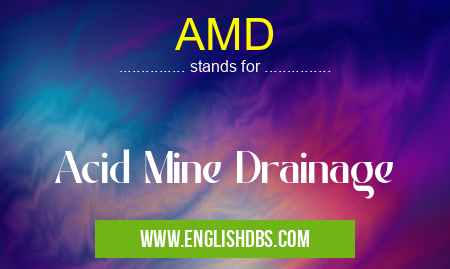What does AMD mean in CHEMISTRY
AMD (Acid Mine Drainage) is a serious environmental problem that occurs when water comes into contact with sulfide-bearing minerals, typically in mining areas. This acidic water can have devastating effects on aquatic life, infrastructure, and human health.

AMD meaning in Chemistry in Academic & Science
AMD mostly used in an acronym Chemistry in Category Academic & Science that means Acid Mine Drainage
Shorthand: AMD,
Full Form: Acid Mine Drainage
For more information of "Acid Mine Drainage", see the section below.
Causes of AMD
- Mining Activities: The primary cause of AMD is the exposure of sulfide minerals to air and water during mining operations.
- Natural Occurrence: AMD can also occur naturally in areas with sulfide-rich rocks and groundwater.
Effects of AMD
- Aquatic Impacts: AMD releases toxic metals into water bodies, harming fish, plants, and other aquatic organisms.
- Infrastructure Damage: The acidic water can corrode metal structures, bridges, and pipelines.
- Human Health: Ingestion of AMD-contaminated water or inhalation of its vapors can cause respiratory and gastrointestinal problems.
Prevention and Mitigation
- Limiting Mining Exposure: Minimizing the disturbance of sulfide-bearing minerals during mining is crucial.
- Water Treatment: AMD can be treated using various methods, such as lime addition, reverse osmosis, and bioremediation.
- Revegetation: Establishing vegetation around mine sites helps stabilize soils and reduce exposure of sulfide minerals.
Essential Questions and Answers on Acid Mine Drainage in "SCIENCE»CHEMISTRY"
What is Acid Mine Drainage (AMD)?
AMD is water that has come into contact with sulfur-bearing minerals in mines or waste rock from mining activities. This water becomes acidic and can contain high levels of dissolved metals and other pollutants.
What causes AMD?
AMD occurs when water reacts with sulfide minerals in the presence of oxygen and water. This reaction produces sulfuric acid and a variety of metal ions.
What are the environmental impacts of AMD?
AMD can significantly degrade surface water and groundwater quality, causing fish kills, reduced biodiversity, and contamination of drinking water sources. It can also damage aquatic ecosystems and infrastructure.
How is AMD treated?
AMD treatment methods include:
- Neutralization to raise the pH of the water
- Precipitation to remove metals from solution
- Passive treatment systems, such as wetlands or bioreactors, to remove pollutants over time
What can be done to prevent AMD?
Prevention measures include:
- Minimizing the exposure of sulfide minerals to water and oxygen
- Sealing abandoned mines to prevent water infiltration
- Using acid-resistant materials in mine infrastructure
Final Words: AMD is a significant environmental issue with far-reaching consequences. By understanding its causes and effects, we can adopt preventive measures and implement mitigation strategies to minimize its impact on ecosystems, infrastructure, and human well-being.
AMD also stands for: |
|
| All stands for AMD |
